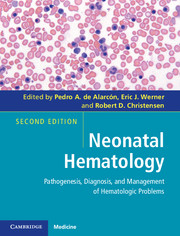Book contents
- Frontmatter
- Contents
- Contributors
- Foreword
- Preface
- 1 A historical review
- Section I Developmental hematology
- Section II Erythrocyte disorders
- 4 Anemia of prematurity and erythropoietin therapy
- 5 Bone marrow failure syndromes
- 6 Hemolytic disease of the fetus and newborn
- 7 Neonatal hemolysis
- 8 Neonatal screening for red blood cell disorders
- 9 Polycythemia and hyperviscosity in the newborn
- Section III Platelet disorders
- Section IV Leukocyte disorders
- Section V Immunologic disorders
- Section VI Hemostatic disorders
- Section VII Transfusional medicine
- Section VIII Miscellaneous
- Index
- Plate section
- References
7 - Neonatal hemolysis
from Section II - Erythrocyte disorders
Published online by Cambridge University Press: 05 February 2013
- Frontmatter
- Contents
- Contributors
- Foreword
- Preface
- 1 A historical review
- Section I Developmental hematology
- Section II Erythrocyte disorders
- 4 Anemia of prematurity and erythropoietin therapy
- 5 Bone marrow failure syndromes
- 6 Hemolytic disease of the fetus and newborn
- 7 Neonatal hemolysis
- 8 Neonatal screening for red blood cell disorders
- 9 Polycythemia and hyperviscosity in the newborn
- Section III Platelet disorders
- Section IV Leukocyte disorders
- Section V Immunologic disorders
- Section VI Hemostatic disorders
- Section VII Transfusional medicine
- Section VIII Miscellaneous
- Index
- Plate section
- References
Summary
This chapter focuses on the recognition and management of hemolysis in newborn infants (Table 7.1). Some of the common hemolytic anemias of childhood first appear in the newborn period, while others do not present until several months of age, and a few rare hemolytic disorders occur only in the neonatal period. These variations in the age that hemolytic anemia first presents reflect differences in neonatal erythropoiesis, hemoglobin synthesis, and the metabolism of newborn erythrocytes. When approaching an infant with a potential hemolytic disorder, the first issue to be addressed is whether there is evidence of increased red cell destruction and accelerated production. If yes, then the next question is to consider whether the cause of neonatal hemolysis is due to extracellular (acquired) factors or an intrinsic (genetic) red cell defect. Acquired disorders are those that are immune-mediated, associated with infection, or accompany some other underlying pathology. Inherited red cell disorders are due to defects in the cell membrane, abnormalities in red blood cell (RBC) metabolism, or a consequence of a hemoglobin defect.
Evaluation of a neonate for hemolysis must be considered in the context of normal newborn physiology. The RBC lifespan in term neonates (80–100 days) and in premature infants (60–80 days) is shorter than in older children and adults (100–120 days) (1). The reason for the reduced RBC survival observed in newborns is not known, although there are many biochemical differences between adult and neonatal RBCs (2–4). Increased oxidant sensitivity of newborn red cells and relative instability of fetal hemoglobin have been considered as possible causes for this shortened lifespan (5). To date, a definitive explanation of the “normal” shortened RBC lifespan of infant red cells remains elusive.
- Type
- Chapter
- Information
- Neonatal HematologyPathogenesis, Diagnosis, and Management of Hematologic Problems, pp. 91 - 117Publisher: Cambridge University PressPrint publication year: 2013
References
- 2
- Cited by

